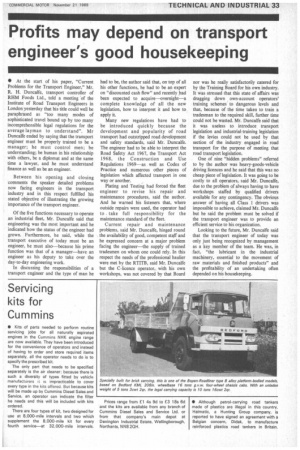Profits may depend on transport engineer's good housekeeping
Page 35

If you've noticed an error in this article please click here to report it so we can fix it.
• At the start of his paper, "Current Problems for the Transport Engineer," Mr. R. H. Duncalfe, transport controller of RHM Foods Ltd., told a meeting of the Institute of Road Transport Engineers in London yesterday that his title could well be paraphrased as "too many modes of sophisticated travel bound up by too many incomprehensible legal regulations for the average layman to understand". Mr Duncan ended by saying that the transport engineer must be properly trained to be a manager; he must control men; be understanding; be human in his relationship with others, be a diplomat and at the same time a lawyer, and he must understand finance as well as be an engineer.
Between his opening and closing comments the speaker detailed problems now facing engineers in the transport industry and in this respect fulfilled his stated objective of illustrating the growing importance of the transport engineer.
Of the five functions necessary to operate an industrial fleet, Mr. Duncalfe said that engineering was the most important and he indicated how the status of the engineer had grown. Furthermore, he said, while the transport executive of today must be an engineer, he must also—because his prime function was that of a manager—have an engineer as his deputy to take over the day-to-day engineering work.
In discussing the responsibilities of a transport engineer and the type of man he had to be, the author said that, on top of all his other functions, he had to be an expert on "discounted cash flow" and recently had been expected to acquire—overnight—a complete knowledge of all the new legislation, how to interpret it and how to apply it.
Many new regulations have had to be introduced quickly because the development and popularity of road transport had outstripped road development and safety standards, said Mr. Duncalfe. The engineer had to be able to interpret the Road Safety Act 1967, the Transport Act 1968, the Construction and Use Regulations 1969—as well as Codes of Practice and numerous other pieces of legislation which affected transport in one way or another.
Plating and Testing had forced the fleet engineer to revise his repair and maintenance procedures, said the author. And he warned his listeners that, where outside repairs were used, the operator had to . take full responsibility for the maintenance standard of the fleet.
Current repair and maintenance problems, said Mr. Duncalfe, hinged round the availability of good, competent staff and he expressed concern at a major problem facing the engineer—the supply of trained tradesmen on whom one could rely. In this respect the needs of the professional haulier were met by the RTITB, said Mr. Duncalfe but the C-licence operator, with his own workshops, was not covered by that Board nor was he really satisfactorily catered for by the Training Board for his own industry. It was stressed that this state of affairs was dragging down own-account operators' training schemes to dangerous levels and that, because of the time taken to train a tradesman to the required skill, further time could not be wasted. Mr. Duncalfe said that it was useless to introduce transport legislation and industrial-training legislation if the levies could not be used by that section of the industry engaged in road transport for the purpose of meeting that road transport legislation.
One of nine "hidden problems" referred to by the author was heavy-goods-vehicle driving licences and he said that this was no cheap piece of legislation. It was going to be costly to all operators, said Mr. Duncalfe, due to the problem of always having to have workshops staffed by qualified drivers available for ally contingency. The obvious answer of having all Class 1 drivers was impossible to achieve, claimed Mr. Duncalfe but he said the problem must be solved if the transport engineer was to provide an efficient service to his organization.
Looking to the future, Mr. Duncalfe said that the transport engineer of today was only just being recognized by management as a key member of the team. He was, in fact, "the lubricant in the industrial machinery, essential to the movement of raw materials and finished products" and the profitability of an undertaking often depended on his housekeeping.




































































































